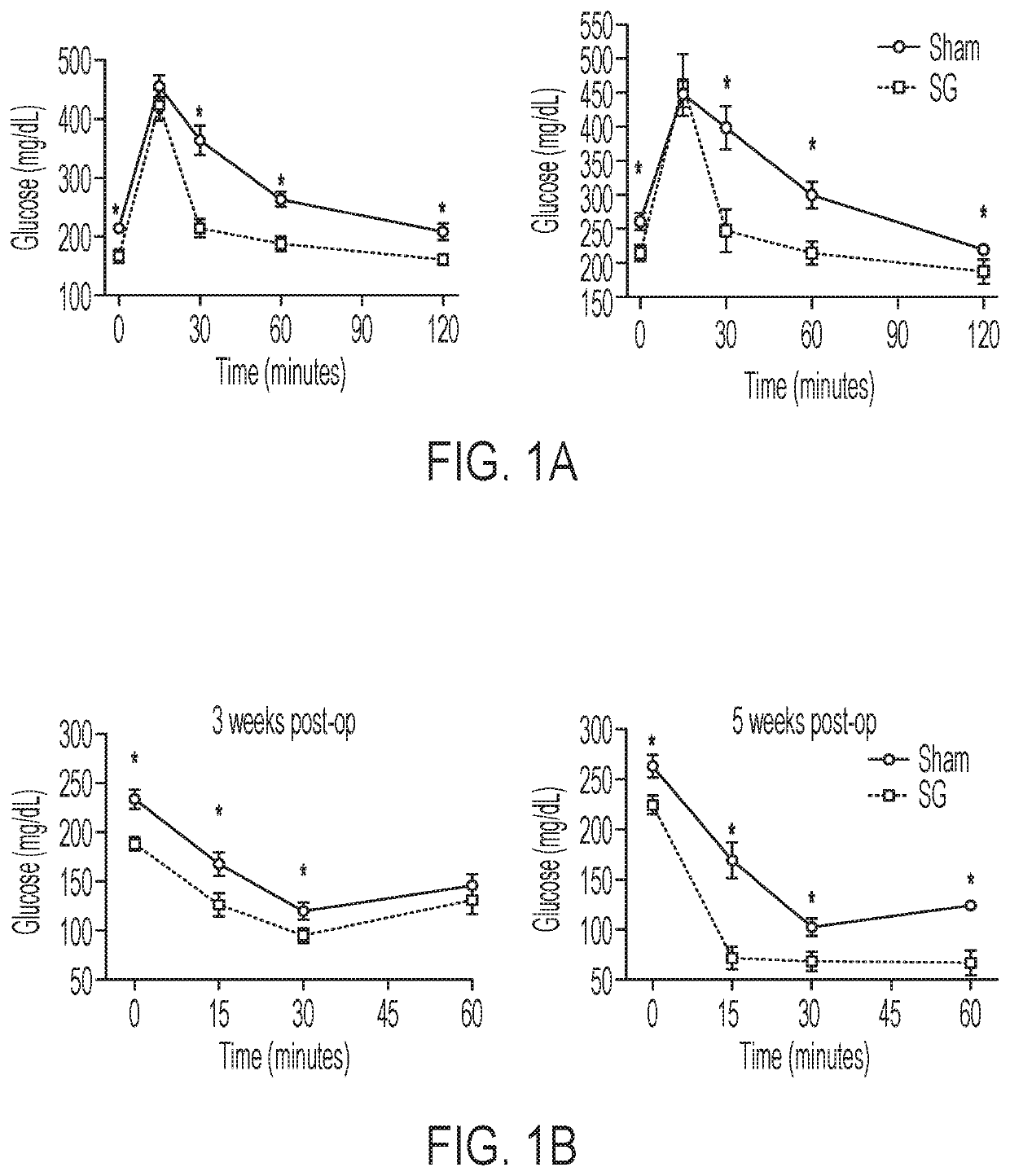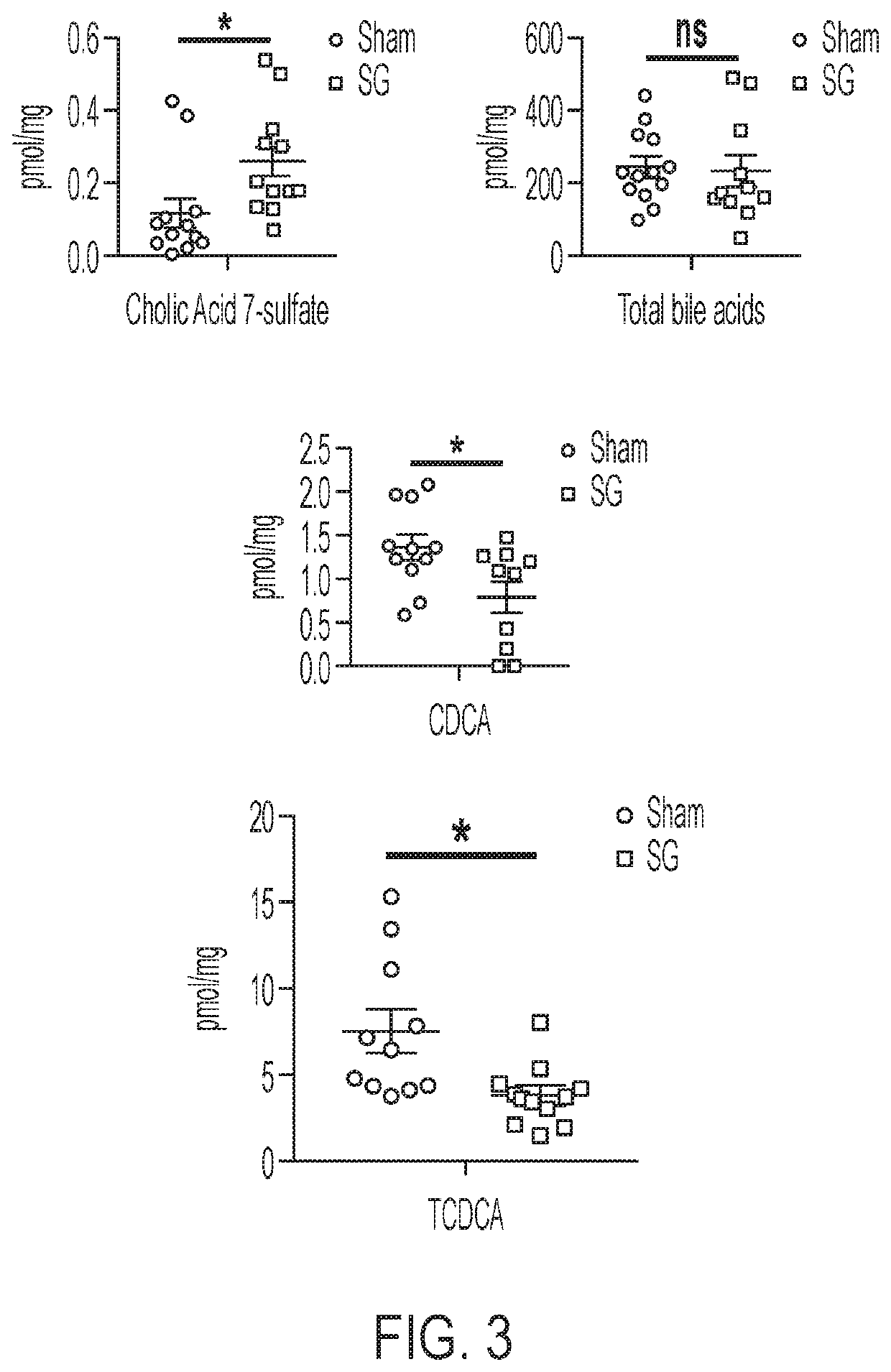Compositions and methods related to cholic acid 7-sulfate as a treatment for diabetes
a technology of cholic acid and diabetes, applied in the field of obesity and diabetes, can solve the problems of reducing the effect of cholic acid 7-sulfate, reducing unclear role, so as to reduce the risk of long-term complications, increase the risk, and reduce the effect of vision
- Summary
- Abstract
- Description
- Claims
- Application Information
AI Technical Summary
Benefits of technology
Problems solved by technology
Method used
Image
Examples
example 1
nd Bile Acid Profiles Post-Gastric Sleeve Surgery Mouse Model
[0165]The mouse model described herein is used to study the amelioration of diabetic phenotypes post-sleeve surgery. Mice are suitable model for bariatric surgery-induced amelioration of diabetic phenotypes. High fat diet-fed mice post-sleeve show improved glucose tolerance and insulin sensitivity (FIGS. 1A and 1B) consistent with what has been observed before in humans.
[0166]Bile acid profiling was performed and revealed significant changes in individual bile acids in mice post-sleeve. Mice 6 weeks post-sleeve have higher levels of cholic acid-7-sulfate in their cecum compared to sham-operated mice (FIG. 2). It was confirmed that the molecule in the bile acid was cholic acid-7-sulfate by NMR. Furthermore, mice post-sleeve have lower levels of secondary bile acid LCA and components of the “CDCA pathway” including CDCA, TCDCA, and iso-LCA in their cecum (FIG. 2).
[0167]The total bile acids and other bile acids did not differ...
example 2
GLP1 and TGR5 Activation with Cholic Acid-7-Sulfate
[0168]It was observed that sleeve mice show increase in GLP-1 in systemic circulation (FIG. 4A). Cholic acid-7-sulfate induces GLP-1 secretion in vitro better than the known GLP-1 inducer TDCA, while cholic acid had no effect (FIG. 4B and FIG. 9).
[0169]To identify a particular target of cholic acid-7-sulfate, it was discovered that cholic acid-7-sulfate-mediated induction of GLP-1 and requires TGR5. This was confirmed when knockdown of TGR5 abolished GLP-1 secretion (FIG. 4B and FIG. 9A). Therefore, cholic acid-7-sulfate is a TGR5 agonist and induces GLP-1 secretion in vitro.
[0170]To further investigate this mechanism, cholic acid-7-sulfate was extracted from cecum of mice and found to also exhibit activity inducing GLP-1 secretion in vitro (FIG. 4C). Cholic acid-7-sulfate activates TGR5 in L-cells, dose response curve shows an EC50 of 0.013 μM (FIG. 4D). Cholic acid-7-sulfate increased calcium levels in L-cells in vitro (FIG. 9B). ...
example 3
duction and Bile Acid Profile in Liver and Blood
[0173]Sulfation is a detoxification method to excrete toxic bile acids. Bile acids have been shown to tightly regulate their own synthesis, conjugation, and sulfation. The liver is the major site for synthesis and sulfation of bile acids, therefore bile acids in the hepatic portal vein were analyzed to determine the origin of sulfated cholic acid and a mechanism for the increase in cholic acid-7-sulfate in sleeve mice. The hepatic portal vein is part of the enterohepatic circulation of bile acids. The liver receives 80% of its blood from the hepatic portal vein. The portal vein has a different repertoire of bile acids compared to circulating blood (FIG. 6B&FIG. 14).
[0174]Mice livers show an increase in SULT2A enzyme isoform 1, previously shown to sulfate bile acids (FIG. 6A).
[0175]To not be bound by a particular theory, it was hypothesized that bile acids in the hepatic portal vein signal in the liver to induce sulfation of cholic acid...
PUM
| Property | Measurement | Unit |
|---|---|---|
| temperature | aaaaa | aaaaa |
| concentration | aaaaa | aaaaa |
| concentration | aaaaa | aaaaa |
Abstract
Description
Claims
Application Information
 Login to View More
Login to View More - R&D
- Intellectual Property
- Life Sciences
- Materials
- Tech Scout
- Unparalleled Data Quality
- Higher Quality Content
- 60% Fewer Hallucinations
Browse by: Latest US Patents, China's latest patents, Technical Efficacy Thesaurus, Application Domain, Technology Topic, Popular Technical Reports.
© 2025 PatSnap. All rights reserved.Legal|Privacy policy|Modern Slavery Act Transparency Statement|Sitemap|About US| Contact US: help@patsnap.com



